|
Is Nemadji Pottery Calling You?
QUESTION:
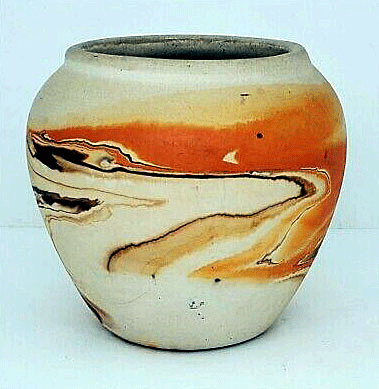 On
a trip out West I traveled through southern Colorado. I stopped at
an antique shop and saw a unique vase covered with swirls of what
looked like colored paint. The dealer said the vase was an example
of Nemadji pottery and that it had been made by Native Americans but
wasn’t sure from what tribe. What can you tell me about my vase? On
a trip out West I traveled through southern Colorado. I stopped at
an antique shop and saw a unique vase covered with swirls of what
looked like colored paint. The dealer said the vase was an example
of Nemadji pottery and that it had been made by Native Americans but
wasn’t sure from what tribe. What can you tell me about my vase?
Thanks,
Paul
_________________________________________________________
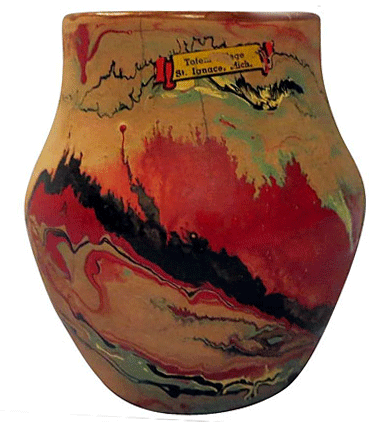 ANSWER:
Nemadji pottery originated in the
Arrowhead region of Minnesota and is touted to be Native American
pottery. But there’s nothing Native American about it. In fact, some
antiques dealers sell this pottery under the belief that it is Native
American. ANSWER:
Nemadji pottery originated in the
Arrowhead region of Minnesota and is touted to be Native American
pottery. But there’s nothing Native American about it. In fact, some
antiques dealers sell this pottery under the belief that it is Native
American.
Nemadji pottery is unglazed rustic pottery with colorful swirled designs
on the outside. No two piece look alike. They all have unique colors and
come in a variety of forms. Reminiscent of ancient Indian pottery, it's
not surprising the colorful swirl pots became one of America's hottest
tourist collectibles.

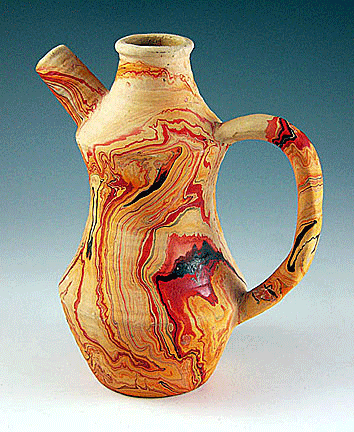 Clayton
James Dodge founded the Nemadji Tile and Pottery Company in Mouse Lake,
Minnesota, in 1923 to make Arts and Crafts ceramic tiles. He shipped its
trademark "fire flash" earthenware tile made from regional clays by
railroad to destinations across the country. During its peak years, the
demand was so strong a crew of 30 men worked three shifts to produce the
colorful tile for homes and churches. But the Stock Market Crash of 1929
put an end to sales. Clayton
James Dodge founded the Nemadji Tile and Pottery Company in Mouse Lake,
Minnesota, in 1923 to make Arts and Crafts ceramic tiles. He shipped its
trademark "fire flash" earthenware tile made from regional clays by
railroad to destinations across the country. During its peak years, the
demand was so strong a crew of 30 men worked three shifts to produce the
colorful tile for homes and churches. But the Stock Market Crash of 1929
put an end to sales.
Determined to ride out the Great Depression, Dodge developed an
inexpensive tourist pottery that could be mass-produced and shipped from
his Moose Lake factory. But to create it, he needed to find a master
ceramist. That person was Eric Hellman, a Danish
immigrant who had earned a bachelor's degree in ceramic engineering at
the Technical Engineering Institute in Copenhagen. Hellman had
previously worked at porcelain houses in Copenhagen and Meissen,
Germany. But by the time he met Dodge, he had given up throwing pots for
fear the clay dust would destroy his lungs. The promise of steady work
and a paycheck changed that.
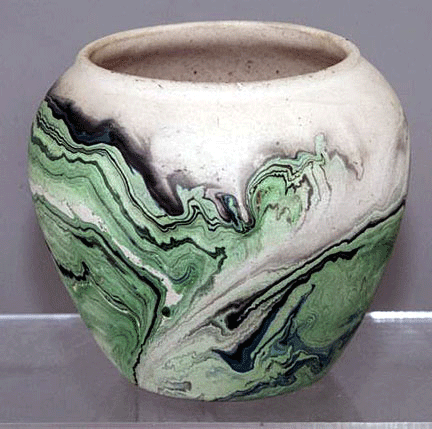 Within
the year Hellman developed a line of hand-thrown pottery for Dodge using
the colorful clays taken from the hanks of the Nemadji River northeast
of Moose Lake. He created molds from these original pieces, then taught
unskilled laborers to recreate them by the slip cast method. Hellman
also introduced a "cold striped painting process," which gave Nemadji
pottery its distinctive look as no two pots were alike. Within
the year Hellman developed a line of hand-thrown pottery for Dodge using
the colorful clays taken from the hanks of the Nemadji River northeast
of Moose Lake. He created molds from these original pieces, then taught
unskilled laborers to recreate them by the slip cast method. Hellman
also introduced a "cold striped painting process," which gave Nemadji
pottery its distinctive look as no two pots were alike.
To apply the paints, workers filled a galvanized wash-tub with water and
a dash of vinegar. They then gently floated onto the water small
droplets of oil-based enamel paint. By blowing gently across the paint,
workers caused the droplets to merge creating colorful bands of paint.
Blowing down into the middle of these floating bands created a circle of
clear water into which a pot. was lowered by hand. When the blowing
stopped the paint returned to the center of the tub. The worker then
lifted the pot out with a twisting motion creating a swirl design.
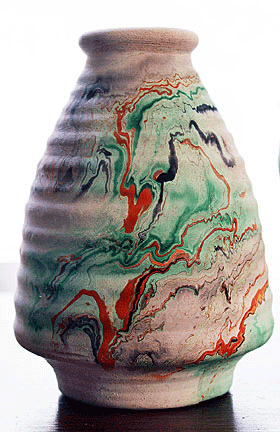 Nemadji
Pottery created between 1929 and 1972 was made with red to buff colored
clays found near Moose Lake. Workers treated the interiors of these
early pots with a quick swish of shellac, recycled from pot to pot,
creating a beautiful patina. Nemadji
Pottery created between 1929 and 1972 was made with red to buff colored
clays found near Moose Lake. Workers treated the interiors of these
early pots with a quick swish of shellac, recycled from pot to pot,
creating a beautiful patina.
Once Hellman had created this unique pottery, he left the company. That
when Dodgers’ began promoting the pottery in earnest. He realized he had
a good product but needed a hook to grab a share of the tourist market.
For that, Dodge sought to tie his pottery's to Minnesota's Indian
Country. A practicing attorney, Dodge used his knowledge of the law and
talents at creative writing to carefully create a legend describing the
geology of Minnesota's Arrowhead region, its first primitive ancestors,
and the remnants of ancient Native American pottery discovered there.
While he never said Indians made Nemadji, Dodge drew a dotted line
between the Ojibwa tribe and his pottery. And shopkeepers and tourists
connected the dots.
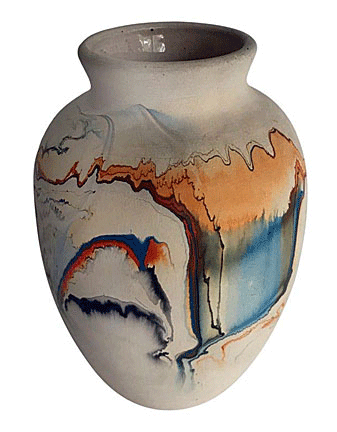 The
legend Dodge created went something like this .”The name "Nemadji" is
the Ojibway word for “left-handed.” Nemadji pottery is made by skilled
craftsmen whose deft hands throw pieces of clay on potters' wheels just
as the Chinese centuries ago turned their pottery, which is today
priceless. These craftsmen are under the three-thin of a skilled
ceramist whose life has been spent in the production of pottery of an
artistic type. Nemadji pottery expresses the soul of the Redman, who,
though long since gone to the Happy Hunting Ground, still haunts our
shores and woods." The
legend Dodge created went something like this .”The name "Nemadji" is
the Ojibway word for “left-handed.” Nemadji pottery is made by skilled
craftsmen whose deft hands throw pieces of clay on potters' wheels just
as the Chinese centuries ago turned their pottery, which is today
priceless. These craftsmen are under the three-thin of a skilled
ceramist whose life has been spent in the production of pottery of an
artistic type. Nemadji pottery expresses the soul of the Redman, who,
though long since gone to the Happy Hunting Ground, still haunts our
shores and woods."
Dodge had his legend printed on a pad of paper and sent with his pottery
to trading posts and tourist stops, including the famed Wall Drug Store
in South Dakota. When a pot sold, the shopkeeper tore a printed legend
from the pad and gave it to the customer. Eager to purchase a small
token of their trips to “Indian Country” and the Wild West, many
tourists didn't hesitate to exchanged their nickels and quarters for a
piece of Nemadji "Indian" Pottery with documentation of its noble
history.
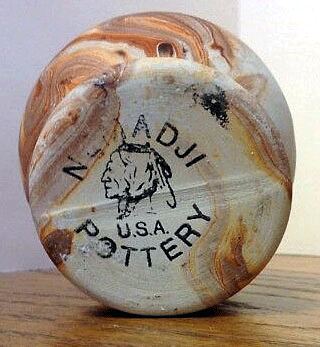 Since
Nemadji sounded like an Native American tribal name, most people thought
it was genuine Native American pottery. Dodge was clever enough say his
pottery was “inspired” by Native American designs. And the tourists
loved it. Since
Nemadji sounded like an Native American tribal name, most people thought
it was genuine Native American pottery. Dodge was clever enough say his
pottery was “inspired” by Native American designs. And the tourists
loved it.
Dodge created rubber stamps to mark each pot. One of the earliest stamp
marks features the image of a Native American arrowhead encircled by the
words “Nemadji Pottery Moose Lake, Minnesota.“ Another early stamp reads
handmade “Nemadji Indian Pottery from Native Clay.”
Most marks carry the words Nemadji Pottery or Nemadji Indian Pottery.
Some are stamped with the words “Badlands Pottery of Nemadji Blackhills
Pottery,” used on pieces sold at Wall Drug in South Dakota during the
1930s and 1940s.
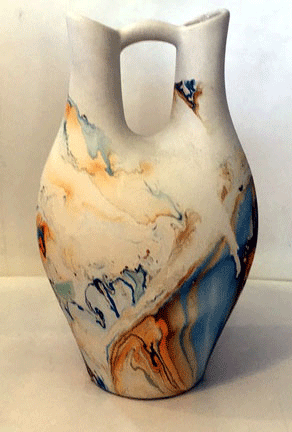 After
1950, pottery marks included the words Nemadji potting and the image of
either an Indian head or an Indian in a canoe. After
1950, pottery marks included the words Nemadji potting and the image of
either an Indian head or an Indian in a canoe.
Over time, people misplaced the small pieces of paper from the pad and
memories faded_ Eventually the owners of Nemadji referred to it simply
as "Indian Pottery" and the Indian myth became reality.
But myths die hard, and today Nemadji pottery often appears for sale in
antique stores and on the Internet as Indian-made, ancient Indian, or as
rare Ojibwa pottery.
Legends aside, Nemadji commands moderate prices in the collectibles
market. And as the interest in this true American tourist pottery
increases, so do the prices. Small hand-thrown Nemadji pieces made by
Eric Hellman in Moose Lake in the early 1930s have recently sold in the
$100 range. Nemadji pottery produced before World War Il using red clays
dug from the banks of the Nemadji River command prices ranging from $75
to $95.
<
Back to Readers Ask Archives
Next Article >
|
